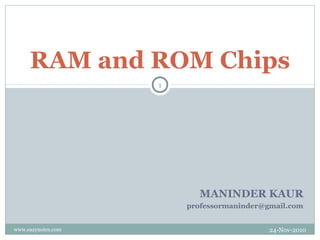
Ram and-rom-chips
- 1. RAM and ROM Chips 1 MANINDER KAUR professormaninder@gmail.com www.eazynotes.com 24-Nov-2010
- 2. RAM Chip 2 RAM is the main memory. It has bidirectional data bus that allows the transfer of data either from memory to CPU during a read operation or from CPU to memory during a write operation. The capacity of the memory is 128 words of eight bits (one byte) per word. This requires a 7-bit address and an 8-bit bidirectional data bus. The read and write inputs specify the memory operation and the two chip select (CS) control inputs are for enabling the chip only when it is selected by the processor. www.eazynotes.com 24-Nov-2010
- 3. www.eazynotes.com 3 24-Nov-2010
- 4. ROM Chip 4 ROM can only read, the data bus can only be in an output mode. For the same size chip, it is possible to have more bits of ROM than of RAM, because the internal binary cells in ROM occupy less space than in RAM. For this reason, the diagram specifies a 512 byte ROM, while the RAM has only 128 bytes. The nine address lines in the ROM chip specify any one of the 512 bytes stored in it. www.eazynotes.com 24-Nov-2010
- 5. ROM Chip 5 www.eazynotes.com 24-Nov-2010
- 6. Memory Address Map 6 A memory address map, is a pictorial representation of assigned address space for each chip in the system. Let us assume that a computer system needs 512 bytes of RAM and 512 bytes of ROM The RAM chips have 128 bytes and need seven address lines. The ROM chip has 512 bytes and needs 9 address lines. The X’s are always assigned to the low order bus lines: lines 1 through 7 for the RAM and lines 1 through 9 for the ROM. It is now necessary to distinguish between 4 RAM chips by assigning to each a different address. www.eazynotes.com 24-Nov-2010
- 7. www.eazynotes.com 7 24-Nov-2010
- 8. MEMORY CONNECTION TO CPU 8 The configuration gives a memory capacity of 512 bytes of RAM and 512 bytes of ROM. The particular RAM chip selected is determined from lines 8 and 9 in the address bus. This is done through a 2 x 4 decoder whose outputs goes to the CS1 inputs in each RAM chip. The selection between RAM and ROM is achieved through bus line 10. www.eazynotes.com 24-Nov-2010
- 9. www.eazynotes.com 9 24-Nov-2010
- 10. www.eazynotes.com 10 24-Nov-2010
